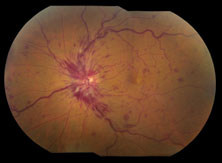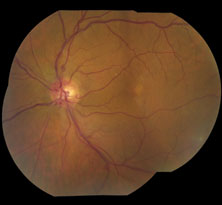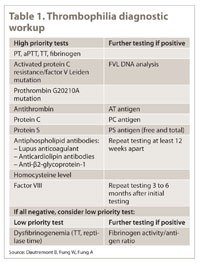Family history can offer clues when making diagnosis
Ocular manifestations are often the presenting signs of life-threatening systemic disease. Diagnosing a common eye disorder in a patient who is within the typical age range of the disorder does not often trigger curiosity about why it is occurring. But ophthalmologists need to remember that we are medical doctors who are responsible for considering a potentially systemic etiology of disease.
In obtaining family histories of both ocular and systemic conditions and then communicating with primary and other specialty physicians, an ophthalmologist can save not only vision but also life. This case summarizes a patient’s ocular presentation of a dominantly inherited trait that caused a death and significant disease in his brothers. Testing for the condition and subsequent treatment have resulted in resolution of the ocular disorder and prevention of systemic consequences.
The case
A 64-year-old Caucasian male patient presented with a chief complaint of 2 months of intermittent “blurred areas” in his left eye vision. Ocular history was significant for amblyopia in the right eye.

Brittney Dautremont

Anne Fung
Medical history was significant for hypertension and hypercholesterolemia. Current medications were verapamil, Zocor (simvastatin, Merck) and daily 81-mg aspirin. Family history was significant for stroke, heart attack and diabetes.
On examination, best corrected visual acuity was 20/60 in the right eye and 20/30+ in the left eye. IOP by applanation was 13 mm Hg in both eyes. Visual fields and motility were normal in both eyes, and no pupillary abnormalities were present. Slit lamp exam was significant for trace nuclear sclerosis in both eyes. No iris neovascularization was present in either eye. Dilated fundus exam was normal in the right eye, but dilated exam of the left eye was significant for marked optic nerve swelling and disc hemorrhages, shunt vessels and dilated venules. Mild, scattered intraretinal hemorrhages were present in the mid- and far-peripheral retina. A few cotton wool spots were present. The patient was diagnosed with a long-standing, perfused, impending central retinal vein occlusion in the left eye. The findings were documented with fundus photography (Figure 1).
Further questioning about the family’s cardiovascular history revealed several events in his brothers at young ages: one brother who died at the age of 44 years from a cerebrovascular accident, a twin brother who had coronary artery bypass graft in his early 50s, and another brother who had a myocardial infarction at age 57 years.
This strong family history of vascular events triggered immediate communication with the patient’s primary care physician, who coordinated a laboratory evaluation for a clotting disorder. His protein C level was abnormally low at 41% (normal 100%), with normal levels of protein S, prothrombin gene and antithrombin III. The patient was started on Lovenox injections (enoxaparin, sanofi-aventis) and Coumadin (warfarin, Bristol-Myers Squibb). A subsequent hematology evaluation supported the diagnosis of protein C deficiency and long-term management with Coumadin.

Figure 1. Long-standing, perfused, impending central retinal vein occlusion of the left eye.

Figure 2. Same eye as in Figure 1, 2 months later. Fundus is near normal with a few collateral vessels on the retina and one retinal hemorrhage still present.
Images: Fung A
Two months later, the intraretinal hemorrhages and vascular congestion were markedly decreased. Seven months later, the fundus was nearly normal with a few collateral vessels on the optic nerve and one retinal hemorrhage still present (Figure 2). The patient has continued on Coumadin therapy and remains free of cardiovascular events 7 years after presentation with the impending central vein occlusion. His visual acuity has remained stable at 20/25 in the left eye.
Discussion
Protein C deficiency is an autosomal dominant inherited disorder of coagulation that increases an individual’s risk for a thrombotic event. Protein C is a vitamin K-dependent protein that works as a natural anticoagulant, thus helping to regulate blood coagulation. When protein C is activated by thrombin, the activated protein C works to inhibit the pro-coagulation proteins factors V and VIII. Should an individual have a lower than normal level of protein C, factors V and VIII will be overactive, leading to an increased risk of venous thromboembolism. Protein C deficiencies are not generally associated with arterial clotting disorders.
Individuals who are homozygous for protein C deficiency present as newborns with a widespread thrombosis called purpura fulminans. But individuals who are heterozygous can be as common as one in 200 adults and present variably. Some heterozygotes have no thrombotic history, while others may have a long history of recurrent thrombosis. Of note, patients with heterozygous protein C deficiency can develop skin necrosis on initiation of warfarin therapy.
Inherited hypercoagulable states are also known as thrombophilic disorders and are found in up to half of patients who present with venous thromboembolism before the age of 45 years. These hypercoagulable states may be caused by a loss of function of natural anticoagulant pathways or by a gain of function in procoagulant pathways. Disorders associated with loss of function of anticoagulation include antithrombin, protein C or protein S deficiencies. Disorders associated with gain of function of coagulation include factor V Leiden, prothrombin, or elevated factors VIII, IX or XI. These patients often have a positive family history of thrombotic events such as early stroke or myocardial infarctions, as in the case of our patient. Other events may include deep venous thrombosis or pulmonary embolism. More mild cases of these inherited disorders may be unmasked by an acquired hypercoagulable state such as pregnancy, malignancy, hormonal therapy, antiphospholipid antibody syndrome or heparin-induced thrombocytopenia.

Source: Dautremont B, Fung W, Fung A
Screening for thrombophilia remains controversial but is generally recommended for patients whose first thrombotic event occurs before the age of 45 years, those with recurrent thrombosis, patients with thrombosis in an unusual site such as cerebral or mesenteric veins, those with two or more first-degree relatives with thrombosis, and women with a history of three or more second-trimester pregnancy losses or an intrauterine death. Ideally, the primary care physician should coordinate the thrombophilia evaluation and management; therefore, prompt and direct communication between the ophthalmologist and primary care physician is critical. The thrombophilia laboratory evaluation may include the tests listed in Table 1.
Taking the time to inquire about the ages at which family history events occurred can have significant diagnostic implications. The fact that our patient had three first-degree relatives with early thrombotic events triggered the hypercoagulable workup that revealed his protein C deficiency. Fortunately, warfarin therapy has allowed for a complete resolution of his central retinal vein occlusion. He has reached age 71 years without any other thrombotic events.
References:
- Anderson JA, Weitz JI. Hypercoagulable states. Crit Care Clin. 2011;27(4):933-952.
- Bereczky Z, Kovács KB, Muszbek L. Protein C and protein S deficiencies: similarities and differences between two brothers playing in the same game. Clin Chem Lab Med. 2010;48 Suppl 1:S53-66.
- Margetic S. Diagnostic algorithm for thrombophilia screening. Clin Chem Lab Med. 2010;48 Suppl 1:S27-39.
For more information:
- Anne Fung, MD, can be reached at Pacific Eye Associates, 2100 Webster St., Suite 214, San Francisco, CA 94115; 415-923-3007; fax: 415-923-6586; email: annefungmd@yahoo.com.
- Disclosures: Dautremont and Wayne Fung have no relevant financial disclosures. Anne Fung receives research funding from Genentech and is a consultant or speaker for Santen, Sequenom, Genentech, Alcon and Allergan.
